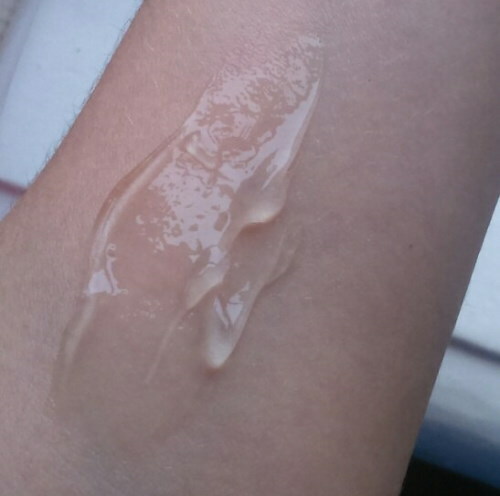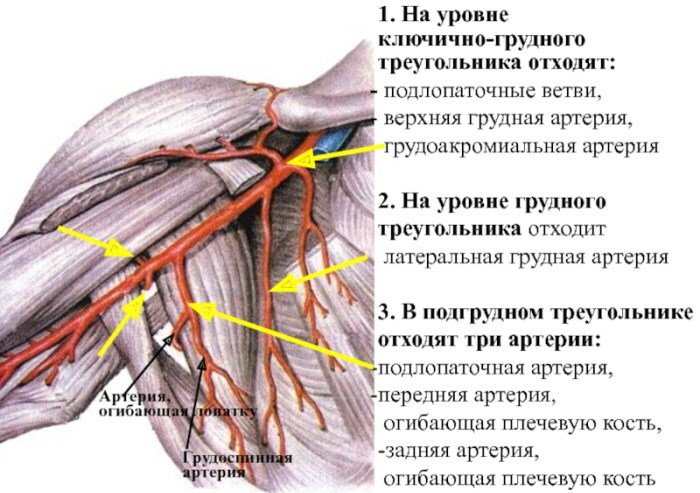Content
- Causes of tachycardia in adults
- Infectious diseases
- Inflammatory heart disease
- Shock states
- Poisoning
- Neurocirculatory asthenia
- Hyperthyroidism
- Anemia
- Mechanical difficulties in the work of the heart
- Damage to the nucleus of the vagus nerve
- Massive bleeding and trauma
- Pheochromocytoma
- Congenital malformations
- Types of tachycardia and their signs
- Sinus
- Ventricular
- Atrial
- Atrioventricular
- Paroxysmal
- Arterial
- Orthostatic
- Tachycardia symptoms
- Increased heart rate
- Increased heart rate
- Carotid artery pulsation
- Shortness of breath on exertion
- Dizziness
- Sense of anxiety
- Pain in the region of the heart
- Diagnosis of tachycardia
- Heart rate measurement
- Heart auscultation
- Phonocardiography
- Electrocardiography
- How to remove an attack of tachycardia, first aid
- Treatment of tachycardia at home
- Drug treatment
- Treatment with folk remedies
- Consequences
- Prognosis for tachycardia
- Video about tachycardia
Tachycardia is a pathologically increased the number of heartbeats. The disorder has multiple causes and requires urgent treatment.
Causes of tachycardia in adults
At the moment, there are more than 10 main factors leading to the development of pathology.
Infectious diseases
Infectious processes lead to the development of inflammatory reactions and an increase in body temperature, which directly affects the work of the cardiovascular system. At the same time, various pathogenic microorganisms produce toxins, which also have a negative effect on the heart.
Any increase in body temperature is believed to raise the heart rate by 8 to 15 beats. In the presence of suppuration, the temperature also rises. When the pus is removed, the heart rate and temperature usually return to normal.
Inflammatory heart disease
There are several forms of diseases, subdivided depending on the localization of the focus of inflammation.
Pathology can lead to disruption of the work of cardiomyocytes, affect various nerve fibers that are responsible for regulating the organ. Ultimately, this leads to the development of unstable tachycardia. At the same time, during the study, signs of arrhythmia are often found.
Shock states
In shock conditions, respiratory function is suppressed and blood circulation is disturbed. At the same time, during the first attacks, a decrease in blood pressure occurs, which leads to an increase in the heart rate. This is explained by the lack of oxygen.
Pathology is dangerous and, in the absence of timely assistance, can be fatal.
Poisoning
In case of poisoning, various toxic substances are formed in the body, which have a direct effect on cardiomyocytes and the sinoatrial node. In some cases, with severe intoxication or poisoning with poison, the vagus nerve may be affected.
With food poisoning, an increase in heart rate is often accompanied by nausea and vomiting. Lack of fluid in the body and in case of electrolyte imbalance, the heart rate also increases.
Neurocirculatory asthenia
This disorder occurs as a result of damage to the central nervous system. In this case, the process can affect all organs and systems, including nerve fibers that are responsible for the work of the heart.
Pathology leads to the development of tachycardia and is often accompanied by irregularities in the heart rhythm.
Hyperthyroidism
Cardiac tachycardia (the causes and treatment of pathology are established individually) can occur against the background of thyrotoxicosis.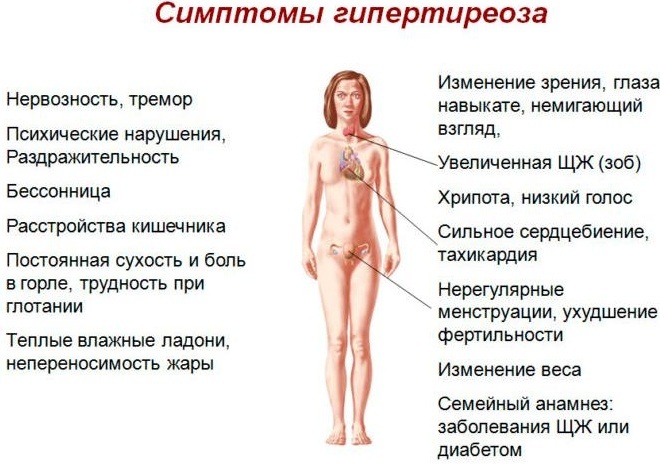
Hyperthyroidism is a pathological process associated with excessive production of hormones by the thyroid gland.
Violation of heart rate often accompanies the disease, since during its development, the level of beta-adrenergic receptors in the heart increases. Against this background, the organ develops a high sensitivity to various substances and hormones.
Anemia
A decrease in the concentration of hemoglobin in the blood in most cases is accompanied by a decrease in the number of red blood cells. Regardless of the form of pathology, their symptoms will be almost the same - tissues and organs will suffer from a lack of oxygen.
An increase in heart rate in this case is a compensatory process.
Mechanical difficulties in the work of the heart
Mechanical difficulties develop against the background of various pathologies caused by abnormalities or structural changes in organs and tissues located in the chest area.
Types of violations:
- Inflammatory process occurring in the area of the outer shell of the heart (pericarditis).
- Pneumonia, pleurisy.

- The presence of neoplasms in the mediastinal region.
- Changing the position of the diaphragm (lifting).
- Deforming changes in the chest area.
When they occur, there is a violation of the blood supply, which leads to a lack of oxygen. In this case, mechanical causes are a compensatory process.
Damage to the nucleus of the vagus nerve
In some cases, it is not the nerve itself that may be affected, but its nucleus located in the brain. With the development of such a process, the relationship of organs and nerve tissues (innervation) is disrupted. This condition leads to the fact that the heart begins to accelerate its work and ultimately leads to tachycardia. The disease occurs in extremely rare cases and requires long and complex treatment.
Massive bleeding and trauma
With a large loss of blood, a drop in blood pressure occurs. To compensate for this, the body strengthens the work of specific baroreceptors that trigger the sympathoadrenal system.
This process leads to increased blood pumping and an increase in heart rate. The condition can last from several minutes to several hours. The restoration of normal heart function depends on the rate at which new red blood cells are produced by the bone marrow.
Injury also leads to an increase in heart rate. The mechanism of development of the pathology depends on the severity of the damage and the accompanying symptoms - pain, shock, the amount of lost blood, trauma to the chest organs.
Pheochromocytoma
A pheochromocytoma is a neoplasm located on the kidneys. With the progression of the disease, an increased production of hormones (adrenaline and norepinephrine) occurs. When injected into the bloodstream, these hormones lead to a sharp rise in heart rate.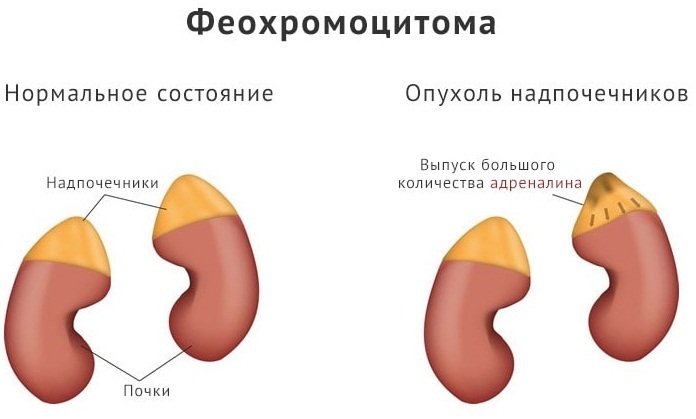
Abnormal heart rate is one of the main signs of tumor development.
Congenital malformations
The abnormal structure of the structures of the heart can lead to the development of tachycardia. For example, valve defects lead to heart failure, which causes oxygen deprivation.
An increase in heart rate in congenital anomalies is a compensatory phenomenon that ensures a normal flow of blood and oxygen to organs and tissues.
Disturbances in the conduction system can also cause tachycardia, since the transmission of impulses through the heart muscle or ventricles is distorted, which leads to an increase in heart rate.
Types of tachycardia and their signs
Tachycardia of the heart (the causes and treatment of the disorder depend on the individual characteristics of the organism patient) is divided into many different forms, depending on the location, degree of damage and causes development. In this case, the signs of each of the forms may differ from each other.
Sinus
This type of disorder is classified according to the regularity of the heart rhythm.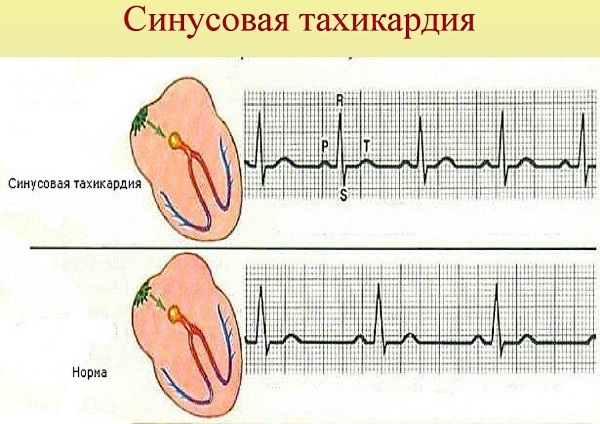
The pathology is characterized by the formation of an impulse in the area of the sinoarterial node. In this case, the intervals between the pulses are the same. The only symptom of the disease is an increase in heart rate. The number of strokes is more than 100. The violation is not dangerous, since the tissues and organs receive a sufficient amount of oxygen.
Ventricular
With this type of disorder, the pulse rate rises to 150 beats per minute. In some cases, this figure can reach 250 strokes per minute.
Symptoms:
- discomfort in the chest area;
- hyperhidrosis (excessive sweating);
- general weakness;
- excited state;
- fluttering of the heart.
In case of violation, the frequency of contractions of the atria and heart muscle of the ventricles also increases.
Atrial
With the development of atrial tachycardia, an increase in atrial contractions occurs. In this case, the function of the ventricles can be in a normal state.
During the development of the disease, the patient experiences a sudden increase in heart rate - from 160 to 240 beats per minute. The condition may be accompanied by shortness of breath, chest pressure, weakness, dizziness, or fainting (in rare cases).
Atrioventricular
This type of disorder is common in most women. Pathology is not associated with cardiovascular disease.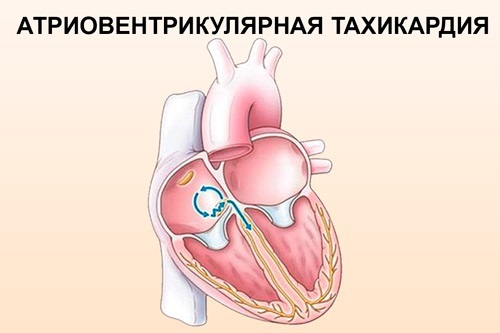
Symptoms:
- lowering blood pressure;
- asthma attacks;
- loss of consciousness;
- throbbing in the neck;
- compressive pains.
The duration of the attacks varies from a few minutes to several days.
Paroxysmal
This type of disorder is characterized by the fact that the rhythm generator is located not in the sinus node, but in the atria or ventricles. The heart rate is between 120 and 220 beats per minute.
The attacks of the disorder come and go quickly enough (sporadically). The heart rate remains elevated during the seizure period, the duration of which ranges from a few minutes to several days.

The condition is accompanied by a noise in the head, dizziness and a feeling of squeezing in the chest area. Nausea, flatulence, and increased sweating may also develop.
Arterial
This disorder is a symptom of other diseases. In most cases, the pathology develops against the background of hypertension or other vascular pathologies.
Signs:
- noise in ears;
- dizziness attacks;
- general weakness;
- dyspnea;
- pulse - more than 100 beats per minute.
The disorder most often occurs in the elderly.
Orthostatic
The orthostatic form of the disease occurs when the position of the body changes, during a sharp rise from bed. At the same time, the number of contractions exceeds normal rates by 40 beats.
The condition is accompanied by the development of dizziness, discomfort in the chest and nausea.
Tachycardia symptoms
Tachycardia itself is a symptom, therefore, it may indicate any internal disorders that lead to an abnormally high heart rate.

Therefore, treatment, first of all, should be aimed at eliminating heart disease.
Increased heart rate
This symptom is typical for most cases. It is associated with improper blood flow and excessive work of the myocardium. At the same time, patients complain about the so-called "sensation of the heart".
Increased heart rate
An increase in heart rate is associated with an increase in heart rate in the area of the ventricles. During the contraction of the heart muscle, there is a sharp reflux of blood into the aorta, which leads to the development of tremors.
Carotid artery pulsation
The principle of development of this symptom is almost identical with the mechanism of development of pulsation on the arm. The easiest way to identify the symptom is in the area of the corner of the lower jaw - in the center between the earlobe and the chin. You can also determine the pulsation in the area under the sternocleidomastoid muscle (located near the Adam's apple). Pulses can be felt elsewhere. This is usually not difficult.
Shortness of breath on exertion
This symptom is not a violation and occurs in healthy people. However, in patients, such a symptom can manifest itself even with minor physical exertion.
This is due to stagnant processes that interfere with normal gas exchange.
Dizziness
This symptom develops against the background of insufficient oxygen supply to the brain tissues. A symptom occurs with a significant increase in ventricular contractions.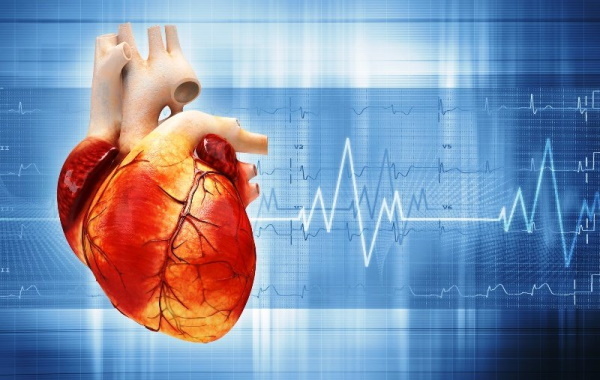
With the atrial form of pathology, dizziness does not develop.
Sense of anxiety
An anxious feeling arises at the level of instincts, as the body reports malfunctions that can lead to a serious condition. This causes anxiety and, in some cases, fear of death.
Pain in the region of the heart
Soreness in the region of the heart occurs in rare cases or in the presence of ischemic disorders and is associated with a lack of oxygen.
With the development of pathology, the myocardium begins to work hard, which leads to the absorption of more oxygen by it. But due to impaired contractility and deterioration of pumping function, the heart muscle does not receive the necessary oxygen supply.
Diagnosis of tachycardia
The disease can be diagnosed through complex laboratory, visual or instrumental studies.
Heart rate measurement
This technique is the simplest way to measure rhythm. In most cases, measurements are taken at the radial artery in the area of the wrist. After feeling for the pulse, the specialist counts the number of beats using a stopwatch. This technique is suitable for initial examinations, since the pulse rate and ventricular contraction may not coincide.
Heart auscultation
Auscultation is the listening of a heart murmur to assess the functioning of the heart valves.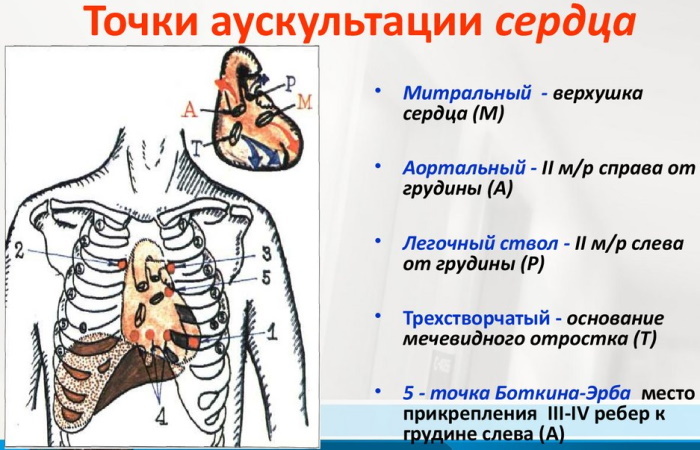
This technique is not suitable for all cases, since it does not guarantee the detection of the disease.
Phonocardiography
The study in this case is carried out using a special apparatus equipped with sensors that are attached to the chest. Diagnostics allows you to determine the presence of a heart murmur.
The device has a higher sensitivity and efficiency, but does not help to determine the cause and mechanism of the development of the disorder.
Electrocardiography
This technique is the most effective and effective, since it allows you to determine the presence of pathology and classify it. The study is mandatory for all patients with various cardiac dysfunctions.
How to remove an attack of tachycardia, first aid
Tachycardia of the heart (the causes and treatment of the disorder may depend on the age of the patient) requires the patient to be aware of the rules for providing first aid to the victim.
At the first attacks of the violation, it is recommended to pour cold water into a large container. Then pinch your nose and mouth with your fingers and immerse your face in water for a few seconds.
Other techniques (vagal tests):
- Irritation of the cough center. The patient just needs to cough.
- Squat Exercise. In this case, you should strain a little.
- Activation of the gag reflex - press on the root of the tongue.
- Valsalva test. Become straight or sit with an even spine. Take a deep breath and pinch your nose and mouth with your finger. Try to push air out of your lungs. During exhalation, it is necessary to strain the anterior wall of the peritoneum.
Also, to relieve seizures, you must always have with you in the first-aid kit such a remedy as Verapamil. The drug will help to quickly eliminate all symptoms and ease the patient's condition before the arrival of an ambulance.
Treatment of tachycardia at home
Therapy should be prescribed by the attending physician, since not all cases require medication. The therapy regimen is developed based on the identified form of the disorder and additional heart problems.
Drug treatment
Drug treatment is carried out only in cases where the tachycardia was caused by various diseases and disorders of the heart. In other cases, taking medications is prohibited, as this can lead to a deterioration in the patient's condition.
| Group of drugs | Mechanism of action | Trade names of funds |
| Beta-blockers |
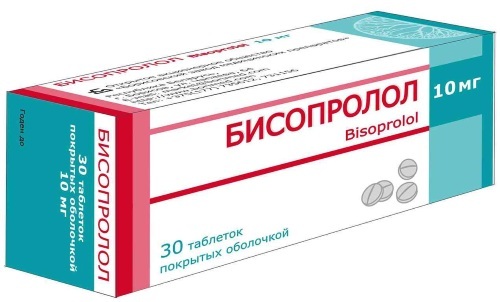 The action of these funds is aimed at reducing the sensitivity of receptors to the effects of adrenaline and norepinephrine. Long-term reception of this group is required. The action of these funds is aimed at reducing the sensitivity of receptors to the effects of adrenaline and norepinephrine. Long-term reception of this group is required. |
Bisoprolol. Timolol Metoprolol Propranolol Atenolol Esmolol |
| Calcium channel blockers | This group of medicines helps to suppress the activity of calcium channels, which are responsible for myocardial contraction. The suppression of their excessive activity leads to a decrease in the manifestations of tachycardia. | Verapamil (in the form of injections or tablets) Diltiazem Nifedipine |
Before taking medications, you must read the instructions for their use and study the list of contraindications.
Treatment with folk remedies
Cardiac tachycardia (the causes and treatment of the disease can be established only after all the studies have been carried out) can be controlled using various home methods.
Folk remedies are allowed to be used only after consultation with your doctor. Moreover, such therapy should be carried out exclusively after the diagnosis and identification of the cause of the development of the disorder.
Recipes:
- Adonis broth. Take 1 tsp. plants and pour 0.2 liters of boiled water. Put the mixture on low heat and boil for 3-5 minutes. Infuse the broth for 2 hours. Consume 1 tbsp. 3 times a day. Duration of admission is several days.
- Eleutherococcus tincture. This tincture can be purchased at any pharmacy. It should be taken according to the instructions in the instructions: 25-30 drops 3 times a day.
-
Infusion of calendula. Take 5 tsp. inflorescences and pour 1 liter. boiling water. Insist for 1 hour. Consume ½ tbsp. 3-4 times a day.

Before using traditional methods of treatment, it is required to familiarize yourself with the contraindications for each of the remedies.
Consequences
Violations in most cases do not pose a threat to human health. Complications can occur as a result of tachycardia caused by malfunctions of the heart itself.
Consequences:
- various forms of thromboembolism;
- heart attack;
- fainting;
- development of edema in the area of the lungs;
- cardiogenic shock;
- death from cardiac arrest;
- weight loss and muscle weakness.
People who do not have any heart disease do not develop these symptoms.
Prognosis for tachycardia
The prognosis for recovery is favorable. In the presence of heart problems, which caused the development of the disorder, the chances of complete elimination of the disease are significantly reduced. However, the condition can be controlled if all the recommendations of the attending physician are followed.
If you have any signs of a heart disorder, you should immediately contact to a specialist who will help determine the cause of the development of tachycardia and prescribe the appropriate treatment.
Video about tachycardia
Heart arrhythmia and tachycardia - how to treat:

